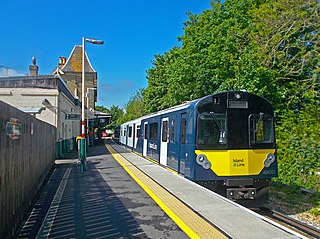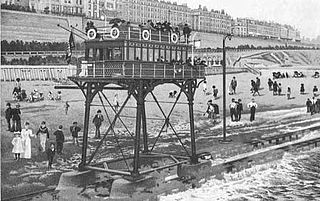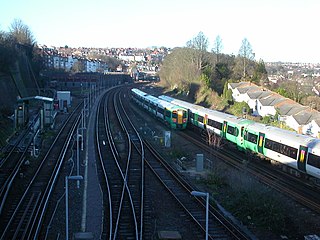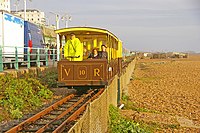
Battersea Park is a suburban railway station in the London Borough of Wandsworth, south London. It is at the junction of the South London Line and the Brighton Main Line, 1 mile 23 chains (2.1 km) measured from London Victoria.

The Island Line is a railway line on the Isle of Wight which runs along the island's east coast and links Ryde Pier Head with Shanklin. Trains connect at Ryde Pier Head with passenger ferries to Portsmouth Harbour, and these ferries in turn connect with the rest of the National Rail network via the Portsmouth Direct Line. The line also connects to the Isle of Wight Steam Railway, a heritage railway, at Smallbrook Junction. For much of its length the line runs alongside the A3055, criss-crossing this road by means of the Ryde Tunnel and bridges at Rowborough, Morton Common, Lake Hill and Littlestairs.

St Kilda station is a current tram stop and former railway station, located in the Melbourne suburb of St Kilda, Australia, and was the terminus of the St Kilda railway line in the Melbourne suburban rail system. It is one of the oldest surviving railway station buildings in Victoria. The building is currently used as retail premises, while the platform serves as stop 132 on tram route 96.

Liverpool James Street is a railway station located in the centre of Liverpool, England; it is situated on the Wirral Line of the Merseyrail network. James Street is an underground station, with access to the platforms via lifts from the booking hall. At certain times, the platforms are accessed via a pedestrian tunnel from the India Buildings on Water Street. As of 2013/14, James Street was the fifth-busiest station on the Merseyrail network.

The Sutton and Mole Valley lines were constructed between 1847 and 1868 by the London, Brighton and South Coast Railway, the London and South Western Railway and the LBSCR-sponsored Horsham, Dorking and Leatherhead Railway.

Three Bridges railway station is located in and named after the village of Three Bridges, which is now a district of Crawley, West Sussex, England. It is at the point where the Arun Valley Line diverges from the Brighton Main Line and Thameslink, 29 miles 21 chains (47.1 km) down the line from London Bridge via Redhill.

The Seaton Tramway is a 2 ft 9 in narrow gauge electric tramway in the East Devon district of South West England. The 3-mile (4.8 km) route runs alongside the Axe Estuary and the River Coly, running between the coastal resort of Seaton, the village of Colyford, and the ancient town of Colyton. For much of its route, it operates between the estuary and the Seaton Wetlands nature reserves, offering views of the wildlife of both.

Barry Island railway station is a railway station, 9+1⁄4 miles (14.9 km) south-west of Cardiff Central, serving Barry Island in South Wales. The station has been the terminus – and only remaining active station at the end of the Barry branch of the Cardiff Central to Barry Island line since the closure of Barry Pier station in 1976, the last passenger working through Barry Island tunnel to the Pier station being an enthusiasts' special in 1973. Previous to that year, only a few revenue-earning workings to meet up with the former P&A Campbell's paddle-steamer trips to Weston-super-Mare or other Somerset/Devon havens, were made following May 1964.

The Great Orme Tramway is a cable-hauled 3 ft 6 in gauge tramway in Llandudno in north Wales. Open seasonally from late March to late October, it takes over 200,000 passengers each year from Llandudno Victoria Station to just below the summit of the Great Orme headland. From 1932 onwards it was known as the Great Orme Railway, reverting to its original name in 1977.

Bidston railway station serves the village of Bidston, Merseyside, England. The station is situated at a junction of the West Kirby branch of the Wirral line, which is part of the Merseyrail network; it also serves as the northern terminus for the Borderlands line from Wrexham Central, with services operated by Transport for Wales.

Tenby railway station in Tenby is on the Pembroke Dock branch of the West Wales Line operated by Transport for Wales Rail, who also manage the station. Trains call here every two hours in each direction, westwards towards Pembroke and eastwards to Whitland, Carmarthen and Swansea.

Culver Depot, also called Culver Terminal or Culver Plaza, was a railroad and streetcar terminal in Coney Island, Brooklyn, New York City, United States, located on the northern side of Surf Avenue near West 5th Street. It was just north of the boardwalk, near the former Luna Park amusement complex, and across from the current New York Aquarium. Originally built by the Prospect Park and Coney Island Railroad for the Culver surface line, it later became a major terminal for the Brooklyn Rapid Transit Company (BRT).

The Brighton and Rottingdean Seashore Electric Railway was a unique coastline railway in Brighton, England, that ran through the shallow coastal waters of the English Channel between 1896 and 1901. It was designed by Magnus Volk to extend his Volk's Electric Railway from its terminus in Paston Place to the village of Rottingdean and avoid difficult terrain. While the unique railway was popular and carried tens of thousands of passengers, it was ultimately abandoned to make room for new sea defences, and Volk was unable to raise the funds to construct a replacement.

Public transport in Brighton and Hove, a city on the south coast of England, dates back to 1840. Brighton and Hove has a major railway station, an extensive bus service, many taxis, coach services, and it has previously had trolley buses, ferries, trams, auto rickshaws and hydrofoils.

The Territet–Glion funicular railway is a funicular in Switzerland, which runs between the Territet and Glion suburbs of the town of Montreux. At its upper terminus, the funicular connects with the Montreux–Glion–Rochers-de-Naye railway line.

Black Rock is an area of beach and promenade located to the west of Brighton Marina and south of Sussex Square in Kemptown in the city of Brighton and Hove. It is one of the terminus stations of the Volk's railway, hosts a 200-year-old living wall, designated as a local wildlife site and including ninety plants such as Euonymus japonicus, and has area of vegetated shingle on the beach, recreated using plants such as Crambe maritima, Glaucium flavum and Solanum dulcamara (bittersweet) under the guidance of horticulturalists at Kew’s Millennium Seed Bank.

Brighton and Hove City Centre is the commercial and cultural centre of the city of Brighton and Hove. Geographically, the so-called city centre is located in an easterly part of the Brighton and Hove urban conurbation.

The Southend Pier Railway is a 3 ft narrow gauge railway in the English city of Southend-on-Sea, Essex. It runs for 1.25 miles (2.01 km) along the 1.34 miles (2.16 km) length of Southend Pier, providing public passenger transport from the shore to the pier head.

The Brighton trolleybus system formerly served the town of Brighton, East Sussex, England. Opened on 1 May 1939, it gradually replaced the Brighton Corporation Tramways network.

Brighton Corporation Tramways operated an electric tramway service in Brighton between 1901 and 1939.





























